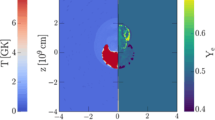Abstract
The possibility that annihilation is a major source of energy in cosmic physics is discussed. Since Klein suggested that the Universe might be matter-antimatter symmetric over two decades ago, there have been a significant number of papers developing the consequences of this view. These, however, have been largely ignored in the general literature. There have also been a number of papers claiming to prove that there cannot be antimatter anywhere in the observable Universe. In the first part of this paper an assessment of the differing views is given, and it is shown that none of the arguments against antimatter is convincing. The existence of antimatter is not in conflict with any observational fact. The reason for the negative attitude towards the existence of antimatter seems to be that this view is in conflict with a number of speculative but ‘generally accepted’ theories. However, recent magnetospheric and heliospheric research, includingin situ measurements of cosmic plasmas, is now drastically changing cosmic plasma physics in a way that leads to growing scepticism about quite a few of the speculative theories.
An attempt is made to develop a simple phenomenological model of QSOs based on star-antistar collisions. This model can account for such basic observational properties as the acceleration to very large (non-cosmological) velocities, the existence of broad emission lines, and at the same time narrow absorption lines with different redshifts. The absence of blueshifts is also explained. The model predicts that relatively young QSOs should be at cosmological distances whereas the old ones may very well be much closer to us than indicated by their redshift.
Similar content being viewed by others
References
Alfvén, H.: 1965,Rev. Mod. Phys. 37 (4), 652.
Alfvén, H.: 1971,Physics Today 24 (2), 28.
Alfvén, H.: 1977a,Rev. Geophys. Space Phys. 15, No. 3, 271.
Alfvén, H.: 1977b, in G. Ekspong and S. Nilsson (eds),Antinucleon-Nucleon Interactions (Wenner-Gren, Vol. 29). Pergamon Press, Oxford and New York, p. 261.
Alfvén, H.: 1978, TRITA-EPP-78-11, Royal Institute of Technology, Stockholm, Sweden.
Burbidge, G. R., Jones, T. W. and O'Dell, S. L.: 1974,Astrophys. J. 193, 43.
Burbidge, E. M. and Burbidge, G. R.: 1978,Physica Scripta,17 (3).
Carlqvist, P. and Laurent, B.: 1976a,Nature 260, 225.
Carlqvist, P. and Laurent, B.: 1976b, Reply to G. Steigman ‘The Cosmic X-Ray Background’,Nature 262, 821.
Colgate, S. A.: 1967,Ap. J. 150, 163.
Dohnani, J. S.: 1976, in H. Elsasser and H. Fechtig (eds),Interplanetary Dust and Zodiacal Light, Springer-Verlag, p. 185.
Elvius, A.: 1970,IAU Symp. 44, 306.
Fälthammar, C.-G., Akasofu, S.-I. and Alfvén, H.: 1978,Nature 275, No. 5677, 185.
Lehnert, B.: 1977,Astrophys. Space Sci. 46, 61.
Lehnert, B.: 1978,Astrophys. Space Sci. 53, 459.
Omnès, R.: 1971,Astron. Astrophys. 10, 228.
Sanders, R. M.: 1970,Ap. J. 162, 793.
Seidle, F. and Cameron, A. G. W.: 1972,Astrophys. Space Sci. 15, 44.
Spitzer, L. and Saslow, W. C.: 1966,Ap. J. 143, 400.
Sofia, S., van Horn, H. M.: 1974,Astrophys. J. 194, 593.
Steigman, G.: 1976a,Ann. Rev. Astron. Astrophys. 14, 339.
Steigman, G.: 1976b,Nature 262, 821.
Thompson, W.: 1978, Private communication.
Thompson, W. B. and Rogers, S.: 1979,Nature.
Vincent, J.: 1976, TRITA-EPP-76-12, Royal Institute of Technology, Stockholm, Sweden.
White, R. S., Rayan, J. M., Wilson, R. B. and Zych, A. D.: 1978,Nature 271, 635.
Author information
Authors and Affiliations
Rights and permissions
About this article
Cite this article
Alfvén, H. Annihilation model of quasi-stellar objects. Astrophys Space Sci 64, 401–419 (1979). https://doi.org/10.1007/BF00639517
Received:
Issue Date:
DOI: https://doi.org/10.1007/BF00639517




